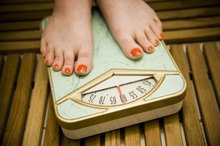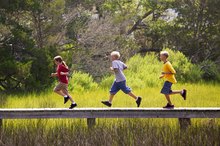Exercise Programs for Obese Children
Almost one in three children are overweight or obese, according to the American Heart Association in 2010 14. In addition to developing increased risks for diabetes, high cholesterol and heart disease, obese children suffer from a variety of psychological and social problems. Creating an exercise program that burns calories, builds muscles and that kids enjoy will help you reduce the serious consequences of obesity for your child 2.
Cardiovascular Considerations
Obesity in children often is the result of a sedentary lifestyle 5. Asking children to elevate their heart rates to a heightened aerobic exercise rate for 30 minutes or longer may be dangerous. Start with an exercise pace that resembles a brisk walk, rather than a jog. Warm up slowly for the first few minutes, let children take breaks as needed and make sure they drink water whenever they become thirsty.
- Obesity in children often is the result of a sedentary lifestyle 5.
- Asking children to elevate their heart rates to a heightened aerobic exercise rate for 30 minutes or longer may be dangerous.
Physical Stress
How to Help My 5-Year-Old Lose Weight
Learn More
Obese children may develop joint or back pain if they perform repetitive, high-impact exercise, which has both feet leaving the ground at the same time. Examples of this would be running, aerobic dancing, jumping jacks or jumping rope. Even a non-impact workout, such as on an elliptical machine, might cause knee and back problems because the child's full weight is on her legs the entire time. Look for exercises that don't put constant weight or repeated impact on the child's legs, feet and hips.
- Obese children may develop joint or back pain if they perform repetitive, high-impact exercise, which has both feet leaving the ground at the same time.
- Even a non-impact workout, such as on an elliptical machine, might cause knee and back problems because the child's full weight is on her legs the entire time.
Beginner Exercise Program
Start slowly, with moderate-intensity, non-impact workouts. Take walks, ride a bike, swim, skate or do calisthenics such as push-ups, sit-ups, crunches or walking stairs. Start doing push-ups from a kneeling position to make them easier. Crunches may be easier because they do not require a child with weak core muscles to go all the way down. Walk and cycle up and down hills to raise and lower the heart rate and use different muscles. Change strokes every few laps when swimming to vary muscle use. Try to add strength, flexibility and endurance exercises to each workout. For example, children can use dumbbells while walking or using an exercise bike.
- Start slowly, with moderate-intensity, non-impact workouts.
- Start doing push-ups from a kneeling position to make them easier.
Intermediate Workout
How to Lose Belly Fat Fast for Kids
Learn More
Raise the intensity level of workouts after the child improves his cardio stamina and muscular endurance. Pick up the pace of walks or rides, trying to finish the course a few minutes early, or adding more minutes. Add a step aerobics workout, which is low impact. Add a few minutes of jumping rope and jumping jacks. Use a treadmill, elliptical machine, rowing machine or exercise bike. Your child does not need to do full aerobic workouts using these machines; just raise his heart rate each week as he improves his condition. Create a circuit training workout that includes a variety of exercise 3. Have the child spend 30 seconds of jumping jacks, 30 seconds of jump rope, 30 seconds of crunches and 30 seconds of stairs. Take a two- or three-minute break, then start another circuit, which might include:
- push-ups
- jogging in place
- squats
- lunges
Keep the circuit going for 30 minutes or more.
- Raise the intensity level of workouts after the child improves his cardio stamina and muscular endurance.
- Take a two- or three-minute break, then start another circuit, which might include: * push-ups
* jogging in place
* squats
* lunges Keep the circuit going for 30 minutes or more.
Make it Fun
Children are more likely to continue exercise if it's fun. Set goals and keep records so children can see improvement. Give rewards when children meet goals. Play games, such as basketball, tennis or volleyball, even if you need to adapt the equipment to make it easier. Lower a badminton net for a mini-tennis court in the driveway, or use a beach ball for longer volleyball points. Exercising with your children sets a good example for physical fitness.
- Children are more likely to continue exercise if it's fun.
- Set goals and keep records so children can see improvement.
Related Articles
References
Writer Bio
Sam Ashe-Edmunds has been writing and lecturing for decades. He has worked in the corporate and nonprofit arenas as a C-Suite executive, serving on several nonprofit boards. He is an internationally traveled sport science writer and lecturer. He has been published in print publications such as Entrepreneur, Tennis, SI for Kids, Chicago Tribune, Sacramento Bee, and on websites such Smart-Healthy-Living.net, SmartyCents and Youthletic. Edmunds has a bachelor's degree in journalism.









